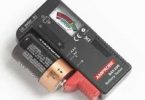Lithium-ion batteries are safer compared to lead-acid batteries. They offer a plethora of benefits for the users. Most of them boast an advanced power management feature making them safer and more convenient. For instance, they are fitted with excellent protection functions that prevent overheating, over-charging, and under-current.
These lithium ion batteries are also designed for designed to be portable and compact. For that reason, they are ideal for your different outdoor needs. They are perfect for tailgating, camping, and other outdoor uses. The batteries are also designed to last longer. They offer to charge and power for most devices.
Our Top Pick
No products found.
Top 10 Best Lithium ion Batteries
No products found.
10 Best Lithium ion Batteries Reviews
No products found.
Is Lithium-ion the Ideal Battery?
For many years, nickel-cadmium had been the only suitable battery for portable equipment from wireless communications to mobile computing. Nickel-metal-hydride and lithium-ion emerged In the early 1990s, fighting nose-to-nose to gain customer’s acceptance. Today, lithium-ion is the fastest growing and most promising battery chemistry.
The lithium-ion battery
Pioneer work with the lithium battery began in 1912 under G.N. Lewis but it was not until the early 1970s when the first non-rechargeable lithium batteries became commercially available. lithium is the lightest of all metals, has the greatest electrochemical potential and provides the largest energy density for weight. Attempts to develop rechargeable lithium batteries failed due to safety problems. Because of the inherent instability of lithium metal, especially during charging, research shifted to a non-metallic lithium battery using lithium ions.
Although slightly lower in energy density than lithium metal, lithium-ion is safe, provided certain precautions are met when charging and discharging. In 1991, the Sony Corporation commercialized the first lithium-ion battery. Other manufacturers followed suit. The energy density of lithium-ion is typically twice that of the standard nickel-cadmium. There is potential for higher energy densities. The load characteristics are reasonably good and behave similarly to nickel-cadmium in terms of discharge. The high cell voltage of 3.6 volts allows battery pack designs with only one cell. Most of today’s mobile phones run on a single cell.
A nickel-based pack would require three 1.2-volt cells connected in series. Lithium-ion is a low maintenance battery, an advantage that most other chemistries cannot claim. There is no memory and no scheduled cycling is required to prolong the battery’s life. In addition, the self-discharge is less than half compared to nickel-cadmium, making lithium-ion well suited for modern fuel gauge applications. lithium-ion cells cause little harm when disposed. Despite its overall advantages, lithium-ion has its drawbacks. It is fragile and requires a protection circuit to maintain safe operation. Built into each pack, the protection circuit limits the peak voltage of each cell during charge and prevents the cell voltage from dropping too low on discharge. In addition, the cell temperature is monitored to prevent temperature extremes.
The maximum charge and discharge current on most packs are is limited to between 1C and 2C. With these precautions in place, the possibility of metallic lithium plating occurring due to overcharge is virtually eliminated. Aging is a concern with most lithium-ion batteries and many manufacturers remain silent about this issue. Some capacity deterioration is noticeable after one year, whether the battery is in use or not. The battery frequently fails after two or three years. It should be noted that other chemistries also have age-related degenerative effects. This is especially true for nickel-metal-hydride if exposed to high ambient temperatures.
At the same time, lithium-ion packs are known to have served for five years in some applications. Manufacturers are constantly improving lithium-ion. New and enhanced chemical combinations are introduced every six months or so. With such rapid progress, it is difficult to assess how well the revised battery will age. Storage in a cool place slows the aging process of lithium-ion (and other chemistries). Manufacturers recommend storage temperatures of 15°C (59°F). In addition, the battery should be partially charged during storage. The manufacturer recommends a 40% charge. The most economical lithium-ion battery in terms of cost-to-energy ratio is the cylindrical 18650 (size is 18mm x 65.2mm). This cell is used for mobile computing and other applications that do not demand ultra-thin geometry. If a slim pack is required, the prismatic lithium-ion cell is the best choice. These cells come at a higher cost in terms of stored energy.
Advantages
- High energy density – potential for yet higher capacities.
- Does not need prolonged priming when new. One regular charge is all that’s needed.
- Relatively low self-discharge – self-discharge is less than half that of nickel-based batteries.
- Low Maintenance – no periodic discharge is needed; there is no memory.
- Specialty cells can provide very high current to applications such as power tools.
Limitations
- Requires protection circuit to maintain voltage and current within safe limits.
- Subject to aging, even if not in use – storage in a cool place at 40% charge reduces the aging effect.
- Transportation restrictions – shipment of larger quantities may be subject to regulatory control. This restriction does not apply to personal carry-on batteries.
- Expensive to manufacture – about 40 percent higher in cost than nickel-cadmium.
- Not fully mature – metals and chemicals are changing on a continuing basis.
The lithium polymer battery
The lithium-polymer differentiates itself from conventional battery systems in the type of electrolyte used. The original design, dating back to the 1970s, uses a dry solid polymer electrolyte. This electrolyte resembles a plastic-like film that does not conduct electricity but allows ions exchange (electrically charged atoms or groups of atoms). The polymer electrolyte replaces the traditional porous separator, which is soaked with electrolyte.
The dry polymer design offers simplifications with respect to fabrication, ruggedness, safety and thin-profile geometry. With a cell thickness measuring as little as one millimeter (0.039 inches), equipment designers are left to their own imagination in terms of form, shape and size.
Unfortunately, the dry lithium-polymer suffers from poor conductivity. The internal resistance is too high and cannot deliver the current bursts needed to power modern communication devices and spin up the hard drives of mobile computing equipment. Heating the cell to 60°C (140°F) and higher increases the conductivity, a requirement that is unsuitable for portable applications.
To compromise, some gelled electrolyte has been added. The commercial cells use a separator/ electrolyte membrane prepared from the same traditional porous polyethylene or polypropylene separator filled with a polymer, which gels upon filling with the liquid electrolyte. Thus the commercial lithium-ion polymer cells are very similar in chemistry and materials to their liquid electrolyte counter parts.






Leave a Comment